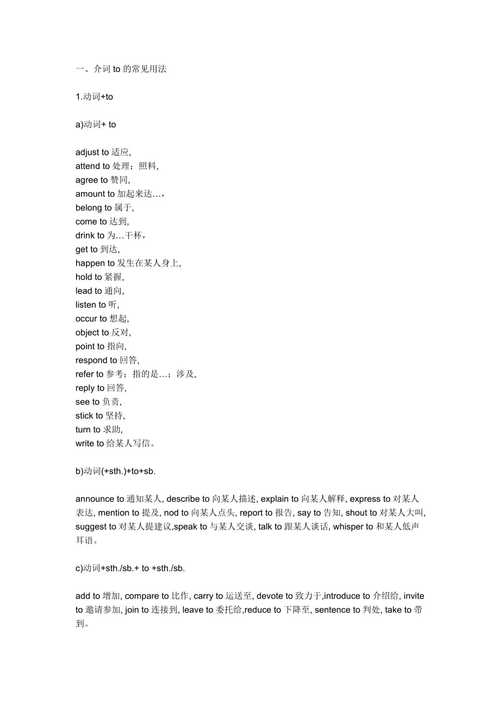to当介词的几种>环境/h2>
1、表示运动、行动或说明运动的朝向情况。它可指达到或想达到的人、地、物。也可指没有达到或者没有完全达到的人、地、物。
1)动作本身有方向性,因而与“to”后所接的地点、人、物构成指向与被指向的关系。

如:drive to the city(开车到城市去)

Low to an acquaintance(向认识的人点头)
run to his mother(跑到他母亲那里去)
2)虽然to前是名词但该名词也含有方向性。
如:on the why to the station(在去车站的路上)
a trip to the moon(到月球旅行)
3)动词虽然无方向性,但此动作与“to”后面的目的也构成“朝向”关系。
如:ware a new hat to the party(戴新帽子去参加聚会)
4)Be+(adj)+to表示主语的>去处/p>
如:A boat is to the dock now(船现在到码头了)
2、表示临时停的地或物
如:He has been to his uncle's house once.(到他叔叔家去过一次)
3、表示方向事物所处的位置
如:The shed is to the side of the house.(小棚屋在房子的一侧)
a tendency to sillness(一种傻头傻脑的趋势)
4、表示接触或邻近,相当于on、upon、against,但较他们更生动,含有某种动态。
如:His mother standing with her hands to her eyes.(...用手蒙在眼上)
在这种用法中,有时“to”前后的词一致,此时词前后无需冠词,表示动作进行时的状态。
5、表示范围所能达到的。
1)用在本身具有伸展性或有回旋余地的动词后
如:The garden extend to the river bank(花园延到河边)
2)用在具有漫长扩张性的形容词之后
如:wet/drench to the skin(浑身湿透)
let in的英解,中文,例句及例句中文
let in :v.
1. allow participation in or the right to be part of; permit to exercise the rights, functions, and responsibilities of
2. allow to enter; grant entry to
及物动词,让…进入
E.G.
Let's open a window and let in some fresh air.
我们打开窗子,让一些新鲜空气进来吧。
You should let me in.
你应该让我进来
ban和forbidden的区别
ban是禁止的意思,而forbidden也是禁止的意思,前者是一个动词,而后者则是一个形容词,区别可以从以下例子看出:
As covid 19 pandemic, this area becomes forbidden area, any entry is banned except authority. 随着covid 19大流行,该区域成为禁区,除授权外,禁止任何进入。













